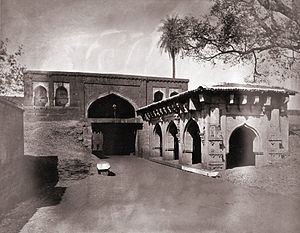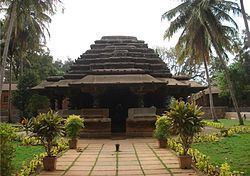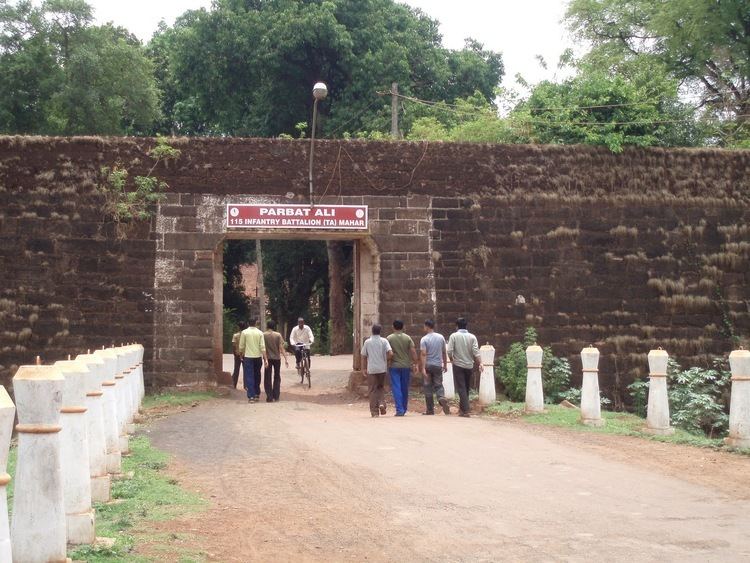Open tothe public Yes Built 13th century | ||
 | ||
Built by Original by Ratta Dynasty and fortified by Yakub Ali Khan of the Bijapur Sultanate | ||
Belagavi Fort or Belgaum Fort, is located in the city of Belagavi, in the Belagavi district, in Karnataka state, India. It was begun by Jaya Raya, also called Bichi Raja, an ally of the Ratta Dynasty, in the year 1204 AD. It has undergone several renovations over the centuries under different dynastic rulers of the region.
Contents

The fort, built with fine ramparts and a large moat, has a rich history with several historical and religious monuments dated to the Adil Shahi dynasty. The fort has been captured in battles many times, as the possession of local rulers, until the region was stabilized by the British Raj. It is also notable in modern history because Mahatma Gandhi was imprisoned by the British in this fort during India’s freedom struggle.

Geography

The fort is situated in the foothills of the Sahyadri mountain range of (Western Ghats) in the precincts of the Belagavi town (which was also known as Belgaum or ‘Venugrama’ meaning 'Bamboo' village), at an altitude of about 762 metres (2,500 ft), 100 km (62 mi) from the Arabian Sea. The Markandeya River flows nearby.
History
The fort’s history is traced to the Ratta Dynasty with lineage to the Rashtrakuta Dynasty (earlier chieftains of Saundatti, who later shifted their capital to Belgaum), Vijayanagara emperors, Bijapur Sultans or Bahmanis, Marathas (Shivaji and Peshwas), and finally by the British in that order. Prior to Rattas, Shatavahanas, Chalukyas and Kadambas from Goa have also ruled over the region. The Belgaum fort belonged to the Ratta dynasty from the time it was built in 1204 AD by a Ratta officer named Bichiraja. Belgaum the city around the fort served as the capital of that dynasty between 1210 AD and 1250 AD. Rattas were defeated by the Yadava Dynasty of Devagiri, and they briefly controlled the fort. At the turn of the 14th century, the Khiljis of Delhi invaded the region and succeeded in ruining both the indigenous powers of the region, the Yadava and the Hoysalas without providing a viable administration. This lacuna was made good by the Vijayanagara Empire, which had become the established power of the area by 1336 AD.
In 1474 AD, the Bahmani Sultanate, then ruling from Bidar, captured the fort of Belgaum under the leadership of Mahamood Gawan. Thereafter, in 1518 AD, the Bahamani Sultanate split up into five small states, and Belgaum became part of the Adilshahi sultanate of Bijapur. The Ismail Adil Shah of Adilshahi dynasty reinforced the fort with the help of Asad Khan Lari (a Persian from the province of Lar) and much of the existing structures dates from 1519 AD.
In Belgaum, the rule of Adilshahs began in the times of Ismail Adil Shah. As Asad Khan Lari, who was a Persian from the province of Lar, assisted Ismail in the battle for the fort, was conferred with Belgaum as his jagir in 1511 AD (in 1519 AD, Asad Khan completed the Masjid Safa in the Belgaum fort).
In 1686, the Mughal emperor Aurangzeb defeated the Bijapur sultanate, and Belgaum came under his control. This was a short-lived control because after the death of Aurangzeb in 1707, the Mughal empire's control declined. With this changed situation, the Maratha confederacy was taken over by the Peshwas. In 1776, Hyder Ali of Mysore won over this region, but only for a short period. The Peshwas, with British assistance, defeated Hyder Ali and regained control of Belgaum. With changed circumstances over the years, the same British attacked the Belgaum fort, which was under Peshwas control, and held it under siege from 21 March to 12 April 1818, and took control of the fort and deposed the Peshwas. Shivalinga Raju, the Kittur Desai, helped the British in this attack on the fort. As a reward, the British allowed Desai to rule over the Belgaum town and the fort.
Fort structure
It is one of the oldest forts in the state of Karnataka. It had fortifications designed to repel attacks of invading armies. It was originally built by Bichiraja (Ratta Dynasty) in 1204.
Located in an undulating plain land, the fort has an oval shape and is surrounded by a deep and wide moat excavated in soft red stone. The external side of the fort is a broad esplanade with bastions which rise to about 32 feet (9.8 m) from the bottom of the moat. The internal dimensions of the fort, which has a level ground, is 1,000 yards (910 m) in length and 800 yards (730 m) in width. Two massive bastions flanked by a large gate, which was originally an entry gate through a bridge, has since been blocked. The gate now in use (said to have been designed by a Brahmin) is considered a fine specimen of Indian architecture. It has a guard chamber, a "groined roof once ornamented with pendants". The exterior of the gate is decorated with large motifs of animals and birds. The gateway is covered by massive doors made of iron designed for defense. An inscription on the top of the arch of the gate in Persian ascribes its building to Jakub Ali Khan. The inscription reads:
Jakub Ali Khan, who is a joy to the heart, by whose benevolence the world is prosperous, built the wall of the fort from its base as strong as the barrier of Sicardis.
It was in 1631 AD that the main gate of the fort was built.
There is a western gate also with an archway, which is guarded only by a chain stretched across two old cannons. This provides access from a sloping road crossed by a causeway over the moat.
The fort has Hindu, Jain and Muslim architectural influence with temples and mosques located within its limits, indicating cultural syncretism. The architectural styles seen in the mosques are of the Indo-Saracenic and Deccan type. The fort has been built with stones and mud. A wide moat runs round the fort.
Jain Temple
Of the two Jain temples inside the fort, the Kamal Basadi, a Jain Basadi with the Neminatha idol in black stone (idol found in a forest nearby) is deified on a stone carved pedestal here, is more famous. It was built in the Chalukyan style in 1204 AD. The other temple, called the Chikki Basadi, is in ruins (see picture). Both Jain temples were built inside the fort in the Chalukyan architecture style. The "Mukhamantapa" (main hall) of this temple is very impressive, with a neatly depicted lotus carving projecting from the ceiling. The mantapa or the main hall is accessed through a number of steps partly enclosed by a balustrade with a large dome of great beauty. Lotus flowers, designed in concave shape, spaced at 1-foot intervals (30 cm), arranged in concentric circles in decreasing layers and depicting a central blossom of the lotus, decorate the roof. The lotus pendant is covered by a large roof in pyramidal shape. The pillars that support the roof with the lotus pendant are founded on plinths. Some pillars made of black basaltic stones (said to have magnetic characteristics) are highly polished. It is named as the Kamal Basadi since the tower of the temple depicts kamal (lotus) with 72 petals, which presently displays images of the past 24 Tirthankaras but can also depict the present and future thirthankars. The pillars of the temple are well carved with decorations and neatly polished. Other idols seen in the temple are of: Bhagwan Sumatinath in the kayotsarga posture, Bhagwan Parshvanath under the shade of seven-hooded serpent (Nagaraj), Bhagwan Adinath in the padmasana posture and the Navagraha. The Archeology Department renovated this temple in 1996.The second Jain temple, though in ruins now, was once considered as a “remarkable piece of Jain architecture”. It has a frontage, which displays festooned rows of dancing figurines, musicians, and trimmed flowers.
Hindu Temple
There are two Hindu shrines at the fort entrance: one devoted to Ganesha, and another to goddess Durga. The Durga temple is dedicated to multi-armed goddess Durga, as considered the goddess of forts and warfare. It is located in a corner of the fort. The outer facade of the temple exhibits painted images of mythological figures.
Mosques
The fort has two mosques or masjids, namely the Safa Masjid and Jamia Masjid; the former mosque is the most frequented by the Muslim population of the city of Belgaum. Safa Masjid was completed in 1519 by Asad Khan Lari (testified by the Persian inscription). The Mosque's pillars have exquisite inscriptions in a fusion of Nagari and Persian styles. It is also said that two of the pillars here are from Hindu temples and have Kannada inscriptions in Nagari scripts; one pillar dated to 1199 AD is credited to Ratta King Kartaveerya IV and the other pillar dated to 1261 AD is credited to Sevuna (Yadava) Krishna. The Jamia Masjid, dated 1585-86, was built by Sher Khan.<
Access
The fort is situated within the precincts of Belgaum city, which is located in the northwestern parts of Karnataka, and lies at the border of two states, Maharashtra and Goa. It is well connected by road, rail and air services to all parts of the country.
Belgaum is connected by road via the National Highway 4 (connecting Maharashtra (now part of the Golden Quadrilateral), Karnataka, Andhra Pradesh and Tamil Nadu) and NH 4A (connecting Karnataka and Goa). The road distance is 502 kilometres (312 mi) to Bangalore (on the Bangalore-Pune highway); 515 km (320 mi) to Hyderabad and 500 km (310 mi) to Mumbai, and it is midway between Bangalore and Mumbai.
The distances to the nearest other cities within and in the border states of Maharashtra and Goa are: Hubbali -94 km (58 mi), Dharwad - 70 km (43 mi), Mangalore - 438 km (272 mi), Goa-125 km (78 mi), Kolhapur - 103 km (64 mi) and Pune - 336 km (209 mi). It is close to the bus station.
The airport currently serving the city is Belgaum Airport at Sambra which is the oldest Airprt in North Karnataka .and is 10 km (6.2 mi) away from the city.
Belgaum is well connected by rail to major destinations such as Bangalore, Mumbai (via Miraj) and Goa.
